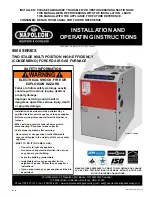
035-17468-001 Rev. A (801)
Unitary Products Group
35
CLEANING THE HEAT EXCHANGER
1.
Turn off the main manual gas valve external to the
furnace.
2.
Turn off electrical power to the furnace.
3.
Remove the upper access panel and remove the burner
box cover.
4.
Disconnect wires from flame sensor, rollout switch and
HSI igniter. Remove igniter carefully, as it is easily
broken.
5.
Remove the screws that hold the burner box assembly to
the vestibule panel and remove the assembly. The lower
portion of the heat exchanger will now be exposed.
6.
Remove the upper cover plate at the top of the furnace.
Remove the internal baffle.
7.
The upper portion of the heat exchanger is now
exposed.
8.
With a long flexible wire brush, clean inside each tube at
both the top and bottom. The brush must pass around
the rear heat exchanger tubes. Vacuum loose scale and
dirt from each tube.
9.
Clean - vacuum all burners.
10. Replace all components in reverse order. Reconnect all
wiring.
11. Restore electrical power and gas supply to the furnace.
12. Check furnace operation.
CLEANING THE SECONDARY HEAT EXCHANGER
1.
Follow steps 1 thru 10 under Cleaning the Primary Heat
Exchanger.
2.
Remove the vent piping from the venter housing. Discon-
nect the drain lines from the venter and from the conden-
sate drain pan. Remove the venter blower and the
condensate pan. The turbulators can then be gently
removed from the secondary heat exchanger.
3.
With a stiff wire brush, brush out loose scale or soot.
4.
Vacuum the secondary heat exchanger.
5.
Finish the cleaning procedure by following steps 10 thru
12 under Cleaning the Primary Heat Exchanger.
VENT/AIR INTAKE
Should it be necessary to service the vent/air intake system,
the manufacturer recommends this service be conducted by
a qualified service agency.
The operation of this appliance requires the reassembly and
resealing of the vent/air intake system.
TROUBLESHOOTING
The following visual checks should be made before trouble-
shooting:
1.
Check to see that the power to the furnace and the igni-
tion control module is ON.
2.
The manual shutoff valves in the gas line to the furnace
must be open.
3.
Make sure all wiring connections are secure.
4.
Review the sequence of operation.
Start the system by setting the thermostat above the room
temperature. Observe the system's response. Then use the
troubleshooting section in this manual to check the system's
operation.
TROUBLESHOOTING THE BLOWER ASSEMBLY
Check to see that there is power to the furnace and the igni-
tion circuit module by turning the furnace power OFF for 5
seconds then ON. The red ignition control LED should light
for an instant then go out.
NO AIRFLOW OR MOTOR DOESN’T RUN
•
Verify that the blower wheel is properly tightened on the
motor shaft.
•
Verify 115 Volts AC at the power connector at the motor.
•
Be sure the connectors at the motor, ignition control and
CFM Selection Board are properly connected and fully
seated.
•
Switch the thermostat to CONTINUOUS FAN mode. If
the motor does not run, verify 24 VAC on the R to C
lines. If there is no voltage correct the cable/wiring, trans-
former fault. If there is voltage at the connector, the
motor has failed.
•
Check High Heat, Low Heat or Cool output terminals for
24 volts.
•
Check motor for tight shaft.
•
Perform Moisture Check. Be sure motor connectors are
facing down. Arrange the wire harness to create a drip
loop under the motor. Check for plugged condensate
drain. Check for low airflow. Check and plug leaks in
return ducts.
MOTOR ROCKS BUT WON’T START
•
Check for loose or compliant motor mount.
•
Perform motor/control replacement check.
MOTOR OPERATION IS INTERMITTENT
•
Verify that all connectors are firmly seated. Gently pull
the motor connector wires at both ends of the cables
individually to be sure they are properly crimped into the
housings.
MOTOR RUNS WHEN IS SUPPOSED TO BE OFF
•
Allow a few minutes for the motor to shut off. Motor-off
delays are controlled by the ignition control.
Label all wires prior to disconnection when servicing
controls. Wiring errors can cause improper and dan-
gerous operation. Verify proper operation after ser-
vicing.


































